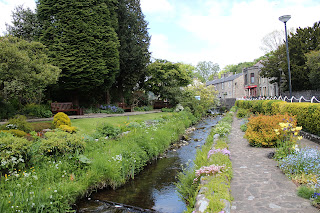Waddington is indeed a pretty village and deserves to be visited just for that reason.
However I knew that there was a memorial there. These are the photos and the inscriptions. Waddington Hall has an interesting history. This is not to be confused with the village of Waddington in Lincolnshire which I am sure is just as lovely.
 |
| The War Memorial |
 |
| Closer Still, Celtic cross |
 |
Close up of the base,
The inscription is below |
THIS CROSS WAS ERECTED BY THE INHABITANTS OF THIS VILLAGE,
IN MEMORY OF THOSE BRAVE MEN WHO SACRIFICED THEIR LIVES IN THE GREAT WAR 1914 - 1918
GEORGE BANNISTER
ALBERT HERD
JOSEPH JACKSON M.M.
ROBERT ROSS
JAMES HANSON M.M.
FRED BROWN
ARTHUR STONES
ROBERT STEWART
ROY BLACK
RICHARD BROTHERTON
ALBERT CHESTER
ENGRAVED BELOW ARE THE NAMES OF
THOSE WHO FELL IN THE SECOND WORLD WAR
1939 - 1945
DAVID WALTER JACKSON.
WILLIAM ROBINSON.
JOHN NOEL WADDINGTON
JOHN HOYLE WHALLEY
 |
| View from the memorial to the church |
 |
| Similar to the above view, but a little further along the path |
 |
I WILL RAISE UP HIS RUINS AND
I WILL BUILD IT AS IN THE DAYS
OF OLD +798. WADA DVX
1900 JOHN WADDINGTON |
This excerpt was taken from the
Ormerod.net family history page:
Its veracity cannot be confirmed - but it does lend a bit of credence to the inscription over the gateway to Waddington hall. I have left the links in and left the page exactly as the family history page - The copy-right is not mine!
In the Craven Herald the Rev. S. T. Taylor-Taswell,
M.A., writes:
"The Waddingtons are a very ancient family, and trace their ancestry to
a period prior to the Norman Conquest, to even Saxon times. The name itself is
territorial, and signifies the town (ton) of the children (ing) of
Wada, and may be traced in such places as Wad-how, Wadsworth, Paddington, and,
strange as it may seem, in Padiham, the abode of Wada, since Pada and Wada were
only variations of the same word.
Their possessions extended over a large part of Yorkshire and Lancashire.
The Anglo-Saxon Chronicle, sub anno 798, records a great fight at Whalley
during Lent, in which, according to Simeon of Durham, Wada Dux was put to flight
by King Eardulfus. Some tumuli near Hacking Ferry attest this battle. One of
them has been excavated, and a model of it is now to be seen in the museum of
Stonyhurst College."
The following references to Wada have also been found.
Extract from Vol. II Symeon of Durham (A.D. 1083),
edited by Thomas Arnold, M.A., published in 1882
~ 59. Anno DCCXCVIII. conjuratione facta ab interfectoribus Etheidredi regis,
Wada dux in illa conjuratione cum eis belium inierunt contra Eardwlfum regem in
loco qui appellatur ab Anglis Billingahoth, juxta Walalege, et ex utraque parte
plurimis interfectis Wada dux cum suis in fugam versus est, et, Eardulfus rex
victoriam regaliter sumpsit ex inimicis. he defeats it.
Translation
In the year 798 a conspiracy was made by the men who had slain King Ethelred,
in which conspiracy Duke Wada joined, and the conspirators fought a battle with
King Eardulf in a place called by the Angles Billingahoth, by Walalege. A very
great number were killed on both sides, Duke Wada and his side were put to
flight, and Eardulf the King obtained a victory in kingly fashion over his
enemies.
Extract from The Rise and Progress of the English
Commonwealth, Anglo-Saxon Period
by Francis Palgrave, F.R.S. and F.S.A., 1832; Northumbria-Angles,
page 313
A.D. 798. Ealdorman [i.e. Earl] Wada at the head of the party which had
slain Ethelred declares war against Eardulf. Battle of Billingaheth near Whalley
in which Wada is defeated [April 2].
The principal seat of the Waddingtons was at
Waddington; near Clitheroe. At
the Survey of "Doomsday Book," Waddington is represented as part of the lands of
Roger of Poitou. By a Survey dated 29 Edw: 1. [A.D. 1301] it appears that
Roger Tempest, by his marriage with the heiress of Walter de Waddington, held
one carucate of the Earl of Lincoln, and he of the King."
A pedigree of one branch of the Waddington Family, descended from the
Waddingtons living in Altham, Lancashire, in the mid-sixteenth century can be
found by clicking on the link below.
Details of the village of Waddington and Waddington Old Hall can be found by clicking on the
following links.
If you follow the links the inscription is mentioned.
 |
This opposite the memorial. The stream
and the Clitheroe road is between me and the Gateway |
 |
| Looking up the stream towards the church |
 |
An early postcard of Waddington,
little in the way of landscaping and of course no traffic.
A closer view will reveal the church. |
This is the reference at the National inventory of War Memorials.
WADDINGTON CROSS WW1 AND WW2
Our Ref:
18663













